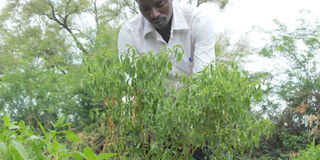Mrenda is a revered vegetable at the Kakuma Refugee Camp

Mahadi Adam Yahya at the mrenda/murere section at the Napata Farm in Kakuma Refugee Camp. PHOTO | KENNEDY KIMANTHI | NATION MEDIA GROUP
What you need to know:
- Mahadi Adam Yahya, a 27-year-old refugee from Darfur in Sudan, is the chairman of the Napata Farm Group. The group that runs the farm comprises of 10 refugees of different nationalities.
- Water from the fishpond is channelled through an underground pipe into a shallow pit from where it is pumped to the vegetable farm, which is sub-divided into 40 plots for better management.
Scorching and dusty; that is how one can best describe Turkana County.
The sweltering sun rays hit the black cotton soil hard as the dry winds carry it away. It is difficult to imagine that crops can survive in such an environment, but that is until you visit Napata Farm in the sprawling Kakuma Refugee Camp.
The farm ran by refugees is easy to pick out from the rest of the camp due to its lush green foliage.
The one-acre farm hosts sukuma wiki, pumpkins, hot pepper, amaranth, cowpeas and a fishpond.
Mahadi Adam Yahya, a 27-year-old refugee from Darfur in Sudan, is the chairman of the Napata Farm Group. The group that runs the farm comprises of 10 refugees of different nationalities.
“We started farming about two years ago after seeing there was increased demand for vegetables in the camp,” Yahya says.
Vegetables are a valued commodity in the camp that accommodates over 180,000 refugees.
“The food rations we receive from the humanitarian agencies do not have vegetables. Families have to purchase them from traders who bring from Lodwar and Kitale towns.”
Of all the vegetables, residents love jute mallow (mrenda). At the camp, it is referred to as murere.
It occupies the biggest section of the Napata Farm.
So how did the refugees get into farming?
After arriving at Kakuma from Darfur in 2012, he teamed up with fellow Sudanese refugees and they started to dig wells for water supply.
“We knew how to develop the shadoof system, which is good for provision of water for domestic and farm use.”
Their activities were spotted by officials of the National Council of Churches of Kenya, who offered to support them start the farming project.
“We identified a proper site, cleared the bush before constructing the 7 by 3m fish pond with the help of the organisation. We stocked it with 500 catfish fingerlings. The project cost about Sh30,000.”
After seven months, they got their first harvest, about 20kg of fish which they sold at Sh600 a kilo to the refugees. Fish is a revered delicacy at the camp. It is the success of the fish project that pushed them into vegetable farming.
They use water that is drained from the pond to irrigate the vegetables. Water from the fishpond is channelled through an underground pipe into a shallow pit from where it is pumped to the vegetable farm, which is sub-divided into 40 plots for better management.
The vegetables take between one and two months to mature. However, they are planted on the different plots to ensure a steady supply throughout the year.
The group buys the seeds from the Hong Kong market at Kakuma camp. For mrenda seeds, a kilo goes for Sh2,000.
Unlike other crops, he says, vegetables are less labour intensive and they mature early.
“A plot of mrenda that measures 3 by 1 metres fetches us Sh300. We have about 40 plots which ensure we have the crop ready at any given time. We harvest weekly and sell most of our produce to traders,” says Yahya.
Through the venture, Yahya has been able to start an electronics shop at the camp where he repairs mobile phones at a fee.
“I was unable to continue with my primary education here after losing my certificates during the war back home. Farming has helped me have a decent livelihood.”
But it is not all rosy. The group faces several challenges that include expensive pesticides and fish feeds, which they have to source from Lodwar or Kitale. A 70kg bag of fish feeds goes for Sh4,000.
Prof Joshua Ogweno, a horticultural expert from Egerton University, says increased demand for traditional vegetables has provided farmers with immense opportunity.
He notes with proper nutrition, traditional vegetables can be grown in all climatic conditions ranging from altitudes of between 10 to 3,000m above sea level. World Food Programme officer in Kakuma Jacinta Abenyo says refugees are normally given maize, beans, cooking oil and salt.
She says that a market assessment conducted last year in the camp found that refugees sell part of their rations to diversify their diets.
“We provide a diet that covers most nutritional requirements but has limited diversity. It is good that some of them have gone into farming vegetables to supplement and diversify what they get for nutritional and commercial purposes. It is a good path to take.”





